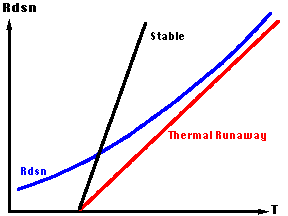Problem
Power MOSFET thermal runaway. The on-resistance of a power MOSFET increases with temperature. With the resistance increase, the power dissipated for a constant on-current increases, the junction temperature increases, and the resistance further increases until the device is in thermal equilibrium with the heat removal system. If the heat removal system is inadequate, thermal run away occurs.
Relevance
Potentially applies to any power MOSFET.
Solvability
Improve the heat removal mechanism.
The existence of the problem can be found by graphically or numerically solving the mutually dependent equations for power dissipation and junction temperature. If no solution exists, thermal runaway exists.
The normal solution is to improve the heat removal system by lowering the thermal resistance from junction to ambient.
Solution
The two equations to solve are:
-
Pt = P1 + Id^2 * Rds(25 C) * Rdsn
Where Pt is the total power dissipated; P1 is the sum of all losses not associated with the drain current; Id is the drain current; Rds(25 C) is the 25 C on-resistance; and Rdsn is the temperature dependence of Rds normalized to 25 C.
- Tj = Ta + Rja * Pt
Where Tj is the junction temperature; Ta is the ambient temperature; Rja is the thermal resistance from junction to ambient; and Pt is the total power dissipation in the MOSFET.

Figure 1: Thermal Runaway Graphical Solution
Figure 1 shows two graphical solutions for the equations. The curved blue line is the plot of normalized Rds on-resistance versus junction temperature. The two straight lines are plots of Rds on-resistance versus junction temperature obtained by substituting the equation for Pt into the equation for Tj. The black line shows the stable case. Junction temperature and Rdsn can be read for the intersection point. The red line (obtained by increasing Id in the equation for Pt) shows the thermal runaway case. In this case, there is no solution for Rdsn versus temperature.
The problem is further discussed in a paper by Rudy Severns, which contains the solution method and equations.
Personal Anecdote
Like many others, I used to list immunity to thermal runaway as one of the advantages of power MOSFETs over bipolar transistors. Then I read Rudy Severns application note and discovered otherwise.
On the Web
Prof. Kolar at the ETH Zurich has produced a series of Java applets as part of an Introductory Course on Power Electronics he teaches. One of the applets demonstrates Thermal Runaway of a MOSFET. The dynamics of Figure 1 above are illustrated by varying four sliders that control:
- ambient temperature
- average drain current (Ids)
- thermal resistance chip to case
- thermal resistance case to heatsink
Normally you should have Java disabled in you browser for security reasons. You will have to enable Java and reload the page to run Prof. Kolar's Java applets. A few minutes spent experimenting with this applet will give you more of an intuitive feel for the problem than is possible on this static web page. You might want to check out other applets at Interactive Power Electronics Seminar (iPES)
References
[SEVE83B] Severns, Rudy, "Safe Operating Area and Thermal Design for MOSPOWER Transistors", Siliconix Application Note AN83-10, as reproduced in "MOSPOWER Applications", Siliconix, Santa Clara, California, 1984.
The intent of the application note is to collect in one place the thermal information needed for power MOSFET design. The author derives the steady state and transient thermal models of a power MOSFET, the mechanisms for power losses, the determination of total power losses and junction temperature, and the implications for thermal design and safe operating area. Includes an explanation of thermal run away in power MOSFET transistors (JF). 16 pages, 30 figures, 3 tables, 36 equations, 6 references.